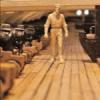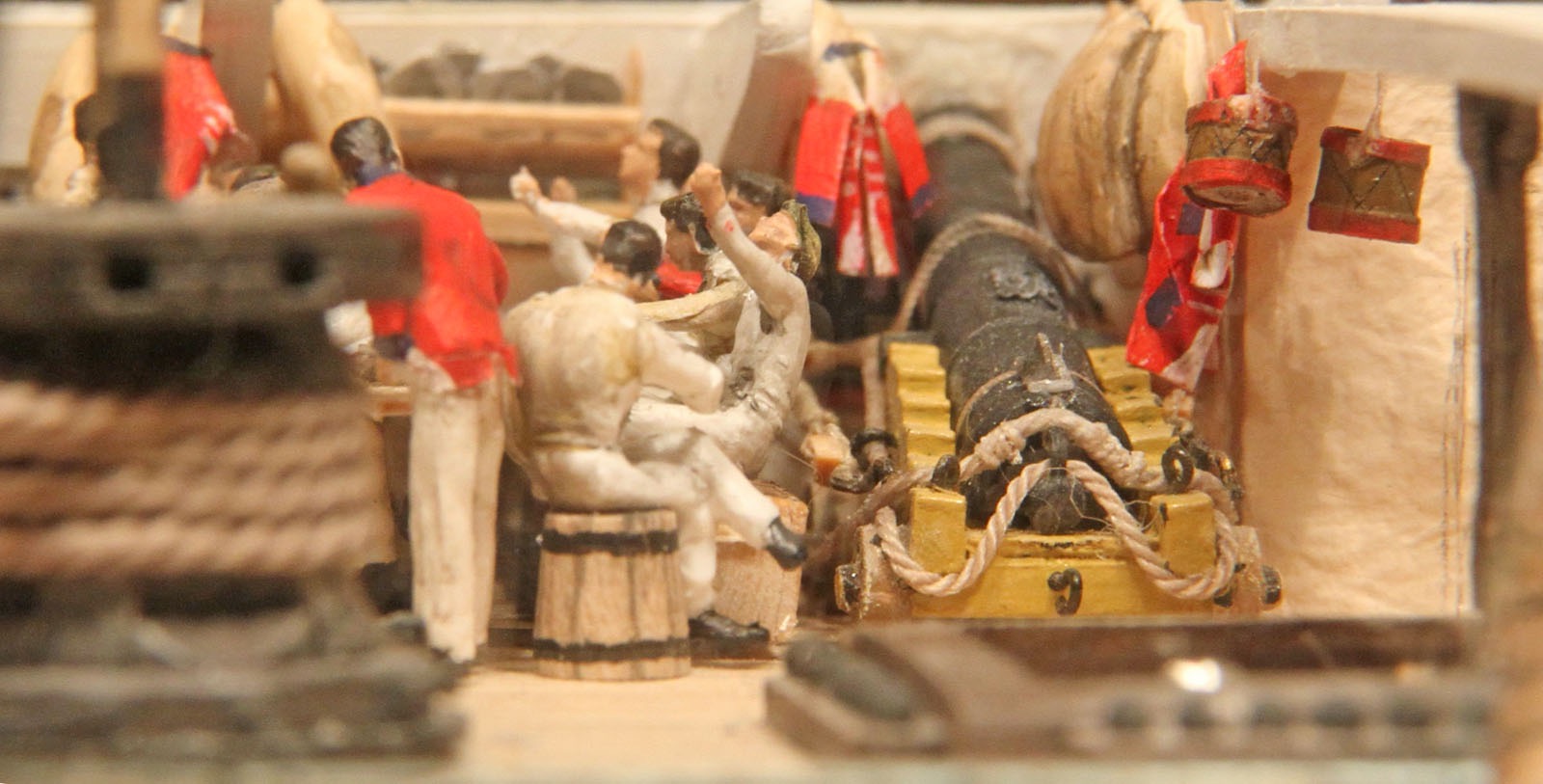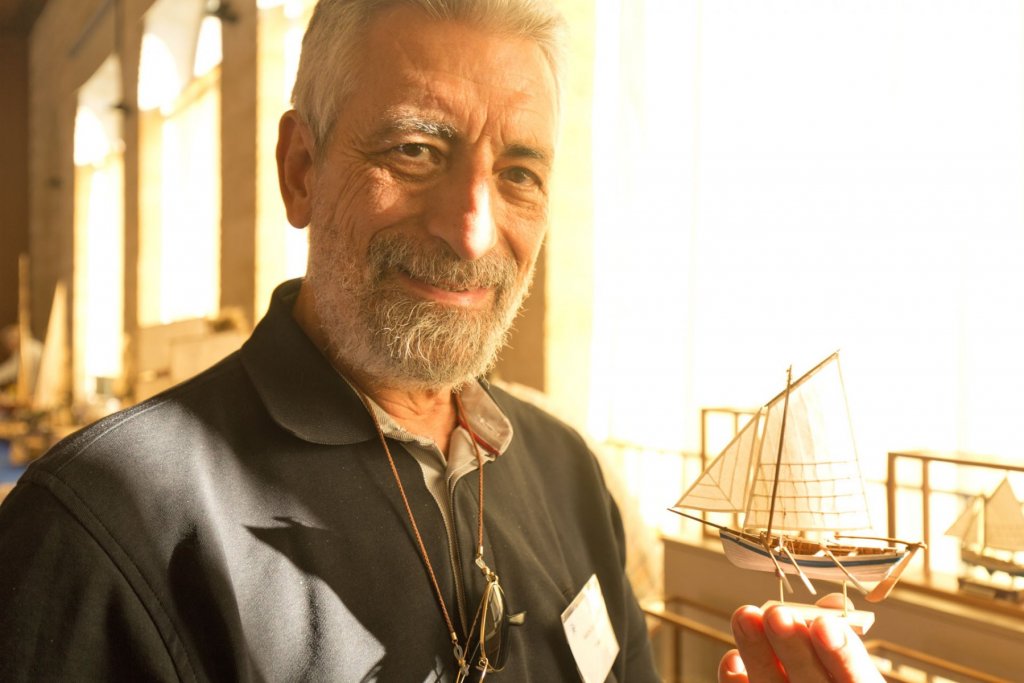-
Posts
2,417 -
Joined
-
Last visited
Content Type
Profiles
Forums
Gallery
Events
Everything posted by dafi
-

Vasa deck shift
dafi replied to BLACK VIKING's topic in Building, Framing, Planking and plating a ships hull and deck
Do every possibly "nodo" imaginable - and that usually you would get your head bitten off here in the forum - and you are most possibly near the reality. As stated all planks have different widths and lengths, the pattern is most random possible and on the quarter deck there are in 1 (one) point/edge 4 (four!) planks joining*** ... XXXDAn *** all different width off course 😉 -
Despite all this X-Mess-stress I found a small space for some advent tinkering 🙂 Started as usual in the smaller scale ... ... and then scratched the fitting Brodi-Stove for it by some scrap materials. Then some trials ... ...for the BBQ-skewer holder and some brass nibbling ... ... bent ... ... and the skewer itself by filing a round brass into a pointed square section. Some trials in soldering but finally it fitted :-). The exhaust air propelled skewer drive was easy ... ... but fitting a 1 mm hole for the external axle bearing into a 1 mm brass profile needed the magical trick of flattening the material before drilling :-). Then some handles and the handrail around and soon some paint could be applied. I think I will go for a nice eloquent black 😉 Always remember: no food - no fight 🙂 XXXDAn
-
Here is the new score: 18 August 1805 1 White 95 lb 2 Yellow 24 lb 3 black 67 lb 4 oil 30 lb White-Yellow Balance 4:1 31 August 1805: 1. White – 120 lb 2. Yellow – 34 lb 3. Black Varnish – 66 gallons 4. Glue – 12 lb 5. Lime – 8 bushels 6. Whitewash brushes – 6 White-Yellow Balance 3,5:1 *** 2 September 1805: 1. White – 150 lb 2. Yellow – 350 lb 3. Black – 150 lb 4. Oil. – 47 gallons White-Yellow Balance 0,4:1 5. White – 66 lb 6. Yellow – 78 lb 7. Black – 13 lb 8. Verdigris (sic) – 5 lb 9. Prussian Blue – 1 lb White-Yellow Balance 0,8:1 6 September 1805: 1. White – 86 lb 2. Yellow – 234 lb 3. Black Varnish – 66 gallons. lb 4. Oil. – 2 1/2 gallons White-Yellow Balance 0,35:1 14 September 1805: 1. White 450 lb 2. Yellow 350 lb 3. Black 150 lb 4. Oil 47 gallons White-Yellow Balance 1:1,3 Not near one is to Nelson´s proposed mixture of 6:1 ... What was all this yellow for?!? XXXDAn
-
@Morgan Thank you Gary, we are having a wonderful discussion about the Turner drawings in our german forum: https://www.segelschiffsmodellbau.com/t7042f198-HMS-Victory-Spurensuche-6.html#msg155492 Perhaps this would be of great interest for you. I took the liberty to link to here too and take over some of your quotes. For stupid german la reasons one have to be inscribed to see the content, but we are usually very fast to grant access. But another question arises: If 6 white to 1 yellow is the mixture, why all that yellow paint (almost twice the amount of white) ? But the carpenter entry on the 14.09. fits well in the timeline as it summons the paint used before unmooring on the 13.09. XXXDAn
-
Fits in nicely with the other data culumated: 24.08.1805 Refit at Spithead: Guns removed, hold emptied, ..., basic clean of the hold, ..., 27.08.1805 Cleaning and restowing of iron ballast, ..., guns back on the ship 31.08, 02.09, 06.09 delivery of the paint 13.09.1805 back to sea 25.09.1805 washed hammocks and aired bedding 09.10.1805 Breadroom whitewashed 21.09.1805 Trafalgar If these deliveries are totalled it gives: yellow 696 lb Black 295,lb White 422 lb Verdisgris 5 lb Prussian Blue 1 lb Surprising is the little amount of black color, half the amount of the yellow. Perhaps they had still black on board or was yellow the predominat color? Or did it take more to cover properly? Just some questions ... XXXDAn PS: already the log entry of after 08.08. the crew was busy on the way home painting quarter deck and ship´s sides.
-
For those also interested in Marine aviation, there was a nice report from the museum in Rochefort at modellmarine: http://www.modellmarine.de/index.php?option=com_imagebrowser&view=gallery&folder=rochefort-marineflieger&Itemid=55 Enjoy, XXXDAn
-
Funny enough the organisators eliminated all references upon Heller and plastic from the model description. Honi soit qui mal y pense 😉 Here a shot down the rabbit hole when she was in France, displaying proudly her colors on Trafalgar day! XXXDAn
-
And what we saw on the Hermione can be seen her on yesterdays slide show on Modellmarine.de http://www.modellmarine.de/index.php?option=com_imagebrowser&view=gallery&folder=hermione-rochefort&Itemid=55 XXXDan
-
Very enjoyable build. I had the luck to see one of those being build in Douarnenez / Brittany. Here a link to my shipyard report: https://www.segelschiffsmodellbau.com/t291f235-Un-Langoustier-pour-Douarnenez-Werftbesuch-bei-der-Skellig.html XXXDAn
- 131 replies
-
- finished
- artesania latina
-
(and 1 more)
Tagged with:
-
Oh it did hurt to see her all alone in the back of the car going to a big trip. What happens if she was bored? Thirstty? Hungry? Or needs a p-brake??? And off it went for the journey, a 1000 km across France to Rochefort. Straight into ships paradise, together with another 150 models and proudly showing the flag ... ... of the german delegation together with the Amerigo from Joachim/Schiffebastler:-) Later still came Chapman´s barge from Alexander / Foxtrott ... ... and the Sphinx from Alexander / Alex M. ... ... and me I was obsolet as the kids played all by themselves. So I used the time ... ... to go and see her great-great-great-...-great niece ... ... together with the other german ship parents that did not have to bother for their small ones 🙂
-
At least the deck was not fixed yet as I have to fix some details still. But in order to be looking smart, neat and tidy, the stern needed some attention. Great o the outside but the inside ... ... still quite worn, so I ground down the old paint and rediscovered the two square holes on the top that I added eons ago to fix the stern quarter davits, but scraped them later as newer research omitted them. Looking more cute. See the two metal bits on the top? Then had to fit the stern part. Great to have good tools. Never thought to use a plain on my plastic tub 🙂 To be able to still look inside later on, I hid two magnets in the side galleries, fitting the two metal bits 🙂 Then came the cover of the tiller head ... ... build the box ... ... removable of course 🙂 And to give a good fit, a frame on the deck was to be build. Quite tricky in that size, so did an external work on some paper, that was removed by being made wet later on. Searched for the wheel and the binnacle, made in February 2012, made a small base ... ... and also smartened the anchor cable for protection ... ... and the deciples came to praise her! And then simply he simply took the model with him ... ... I needed to be strong then ...
-
In-between some necessary private restructuring, moving place, plenty of work in the office, workshop full of moving boxes, to nice weather to stay inside and other reasons I was neglecting my dear little small one. Unfortunately ... But then came the day, and a job, an important job was to be done and I was able to hold my small one in my arms again ... ... and some serious cleaning was the job of the day. Time to be surprised: "Oh how did I achieve all this? Have to read the building report in MSW to believe." She needed to be look beautiful, really beautiful. The big mess was still the slots, intended for the insertion of the upper decks. So I had to protect her. But all ok, the plastic protected the lower deck from the biggest dirt from the carnage of the upper decks. Then fixed the spriketting. Then engraved the planking in situ - should have done before - and bent the water ways. Added sone deck beams and evened up the knees ... ... and splashed some color and it looked much more clean and crisp in the inside. The only problem with my way of building are the breaking parts on the way, even half the complement of the heads didn´t give a **** and did **** off ... Then came the moment I was able to do a dry fit of the upper deck 🙂
-
And there she stood, well packed to be shipped far off. What the hell happend? The end of this building report?
-

"Gunnery notes" from William Rivers (*1755, †1817)
dafi replied to dafi's topic in Nautical/Naval History
Having had an actual discussion in our german forum we came to another interesting interpretation: "The Victory had white hammock cloth spread loosely over the others and kept wet until they commenced firing." The interpretation was that the hammocks were covered by a second layer of cloth to keep fire hazard down. Any opinions? The other question concerns the Structure of the hammock cranes with the horizontal bars, also to be seen on some drawings. Any idea about this feature? Are there any further informations about this drawing and Richard F. Roberts, midshipman on the Vic at Trafalgar? What is the source and the date of this drawing? Straight after the battle or a look back in later years? And of course, still looking for a source of: Royal Naval Museum: William Rivers (1755-1817), gunner on HMS Victory: gunnery notes (Acc 1998/41) http://www.nationalarchives.gov.uk/accessions/1998/98returns/98ac1070.htm -
You are going to laugh, you are not the first one to ask this and actually there are already some left-overs spread in several builds around the world :-) Cheers, Daniel the destroyer!
About us
Modelshipworld - Advancing Ship Modeling through Research
SSL Secured
Your security is important for us so this Website is SSL-Secured
NRG Mailing Address
Nautical Research Guild
237 South Lincoln Street
Westmont IL, 60559-1917
Model Ship World ® and the MSW logo are Registered Trademarks, and belong to the Nautical Research Guild (United States Patent and Trademark Office: No. 6,929,264 & No. 6,929,274, registered Dec. 20, 2022)
Helpful Links
About the NRG
If you enjoy building ship models that are historically accurate as well as beautiful, then The Nautical Research Guild (NRG) is just right for you.
The Guild is a non-profit educational organization whose mission is to “Advance Ship Modeling Through Research”. We provide support to our members in their efforts to raise the quality of their model ships.
The Nautical Research Guild has published our world-renowned quarterly magazine, The Nautical Research Journal, since 1955. The pages of the Journal are full of articles by accomplished ship modelers who show you how they create those exquisite details on their models, and by maritime historians who show you the correct details to build. The Journal is available in both print and digital editions. Go to the NRG web site (www.thenrg.org) to download a complimentary digital copy of the Journal. The NRG also publishes plan sets, books and compilations of back issues of the Journal and the former Ships in Scale and Model Ship Builder magazines.





